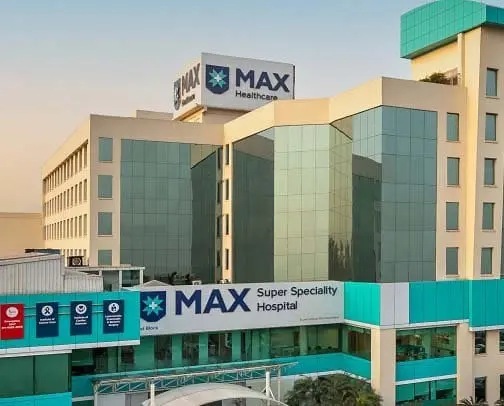1. At a Glance
Max Healthcare is that one hospital chain in India which behaves like a Bollywood superstar—loves expansion, keeps buying properties, and somehow manages to look richer every year despite always “being busy.” With amarket cap of ₹1,14,945 crore, acurrent price of ₹1,181, and astock P/E of 81.6, Max is basically trading like a startup that discovered a cure for “premium valuation syndrome.” Yet, the last quarter’s numbers justify the swagger:Q2 FY26 revenue ₹2,135 crore,PAT ₹491 crore(up a spicy74.3%YoY), and an occupancy rate of77%, which is higher than most engineering colleges during placement season.
Their ARPOB, a.k.a. the “Average Revenue Per Occupied Bed,” sits at₹77,000, proving that North Indians may avoid gyms and cholesterol checks, but when they get sick, they go all-in. EBITDA per bed dropped slightly from FY24’s ₹74 lakh to₹71 lakhin H1 FY25, but Max compensated by acquiring hospitals faster than Zomato buys quick-commerce startups. Jaypee Healthcare? Bought. Alexis Nagpur? Bought. Sahara Hospital Lucknow? Bought. Greenfield Dwarka hospital? Of course. All this while debt climbed to₹3,275 crore, up from ₹913 crore in FY22—but hey, what’s expansion without a little leverage?
By the end of this article, you’ll either admire Max Healthcare’s empire-building game or fear that one day they’ll acquire your building and convert it into a 200-bed specialty center. Buckle up.
2. Introduction
Picture a hospital chain that behaves like a private equity fund—hungry, ambitious, and always scanning for distressed assets to pounce on. That’s Max Healthcare.
In a world where hospital chains fight for market share like cats in a sack, Max has built a fortress in North India. From Delhi NCR to Bathinda, Mohali to Mumbai, Dehradun to Bulandshahr—not even the Himalayan foothills are safe from their teal-colored branding.
This is a company that doesn’t expand—itproliferates. They don’t acquire—theyannex. When a 500-bed hospital sneezes, Max Healthcare shows up with a cheque and a term sheet.
But beneath this expansionist comedy lies a seriously efficient core:
- OPM of 27% TTMis the kind of margin you usually see in software companies, not hospitals dealing with aunties demanding “ek baar aur blood pressure check karwao beta.”
- Sales growth of 46% over 5 yearsshows they aren’t just adding beds—they’re filling them.
- PAT growth of 80.5% over 5 yearsproves they’re filling them with profitable patients, not “sir card swipe nahi ho raha” types.
And thanks to high FII ownership (51.8%), Max is also the “foreign investor favourite”—like the Virat Kohli of hospitals.
The question is:Are they building a medical empire… or are they one capex cycle away from needing an ICU themselves?
Let’s investigate.
3. Business Model – WTF Do They Even Do?
Max Healthcare runs hospitals, clinics, diagnostics, and increasingly, your entire life. Their business model is simple:You fall sick → they bill you → you complain → they bill you again → you recover → they buy another hospital.
Their operations span three big verticals:
1) Max Healthcare (Hospitals)
The bread, butter, butter chicken, and revenue generator of the empire.They provide everything from:
- Cardiac care
- Orthopedics
- Oncology
- Neurosciences
- Transplants
- Radiology
- Pathology
- Preventive health
Basically, if it can be cut, scanned, replaced, or stitched… they do it.
With22 healthcare facilitiesand5,000 beds, they’ve turned North India into their personal NHS, minus the free healthcare part.
2) Max@Home
For those who would rather stay on their sofa with Netflix than visit a hospital lobby. Services include:
- Physiotherapy
- Home lab tests
- Dialysis
- Medicine delivery
- Mother-child care
They do3,000+ transactions per day, proving India’s real economy runs on old people getting sugar tests done every morning.
3) Max Lab
The diagnostics arm working outside the hospital network.Stats from Q2 FY25:
- 475 partner-run
- centers
- 24 company-owned centers
- 1,150+ active partners
- 165+ phlebotomists poking citizens on a daily basis
Diagnostics is the business where margins smile even when the patient doesn’t.
International Business
They run PACs across9 countriesbecause apparently half the world wants to get treated in Delhi.
Verdict
The business model is basically a three-layer biryani—high-value hospitals, scalable diagnostics, and asset-light home healthcare. A clean system that prints cash.
4. Financials Overview (Quarterly Comparison)
All numbers in ₹ crore (as per screener).
| Metric | Latest Qtr (Sep 2025) | YoY Qtr (Sep 2024) | Prev Qtr (Jun 2025) | YoY % | QoQ % |
|---|---|---|---|---|---|
| Revenue | 2,135 | 1,707 | 2,028 | 25.1% | 5.3% |
| EBITDA | 575 | 451 | 523 | 27.5% | 10.0% |
| PAT | 491 | 282 | 308 | 74.3% | 59.4% |
| EPS (₹) | 5.05 | 2.90 | 3.17 | 74.1% | 59.3% |
Witty Commentary:This is the kind of YoY growth that makes other hospital chains quietly close their investor relations WhatsApp groups. PAT jumping 74% is pure North Indian revenue magic. QoQ PAT at +59% suggests either patients got richer or hospitals got smarter.
5. Valuation Discussion – Fair Value Range Only
Method 1: P/E Based
- EPS TTM =₹14.0
- Industry P/E =55.2
- Current P/E =81.6
Low-end fair P/E:55 → FV = 14 × 55 =₹770High-end fair P/E:75 → FV = 14 × 75 =₹1,050
Method 2: EV/EBITDA
- EV =₹1,17,723 crore
- EBITDA TTM =₹2,109 crore
- EV/EBITDA = 52.1 (lol)
Industry reasonable range = 25–40
Low-end:2109 × 25 =₹52,725 crore EVHigh-end:2109 × 40 =₹84,360 crore EV
Equity value = EV – DebtDebt =₹3,275 crore
Fair equity value range:₹49,450–₹81,085 crore → per-share range approx₹510–₹830
Method 3: Simple DCF
Using:
- 10-year sales CAGR: not available
- 5-year CAGR: 46%
- 3-year CAGR: 21%
So assume8–12% long-term FCF growth, discount rate 11%.
DCF fair value indicates₹850–₹1,150depending on growth assumptions.
Consolidated Fair Value Range:
👉₹770 to ₹1,150
Disclaimer:This fair value range is for educational purposes only and is not investment advice.
6. What’s Cooking – News, Triggers, Drama
Max Healthcare’s newsroom looks like a Bollywood gossip site—always something

